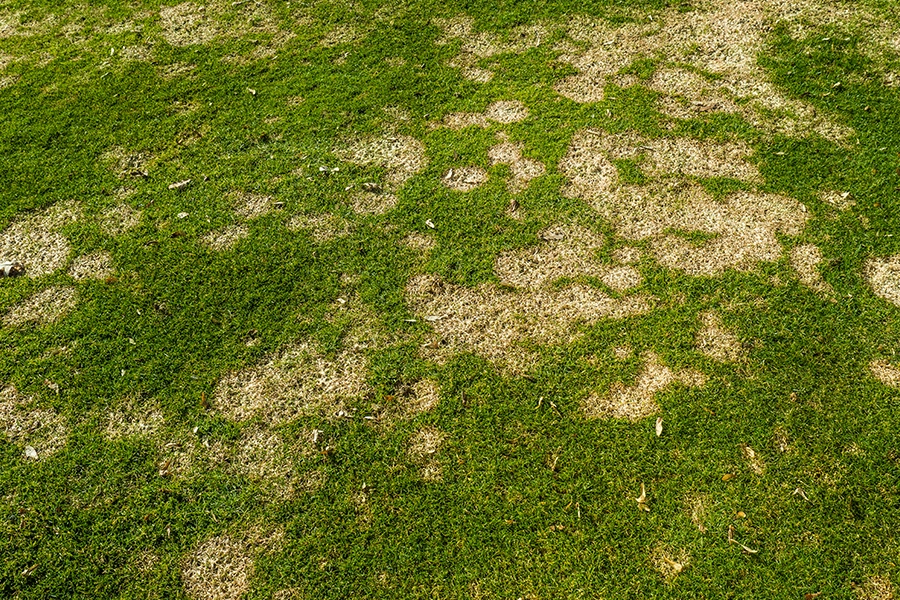Lawn fungal diseases take on a variety of forms – from dead-looking brown patches to highly visible spots, threads, rings, or slimes. And once they strike your yard, grass fungal diseases can be difficult to treat.
Fortunately, the right lawn care practices can go a long way toward prevention and treatment. In severe cases, a fungicide can help eradicate the spores and keep the disease from spreading. Here are some tips for preventing and treating fungal diseases in your lawn.
Causes of Lawn Fungal Disease
Your lawn is naturally full of fungi and spores, some harmless and some problematic, but the right (or wrong) conditions can cause grass fungus to erupt into a harmful disease. The most common causes of lawn fungal disease are:
- Drought
- Improper mowing (especially mowing too low)
- Compacted soil
- Overwatering
- Too much fertilizer (or using the wrong kind)
- Wrong grass type for your yard
- Weather conditions (particularly temperature and humidity)
How To Identify Lawn Fungal Diseases
Signs that your lawn may have a fungal disease include:
- White, yellow, or brown patches or rings that grow in diameter.
- Thin patches of frayed, distorted, or discolored grass blades.
- Gray, black, red, orange, or purple spots on blades or stems.
- Gray, black, or pink powdery or threadlike coatings on and around grass blades.
- Areas of darkened, wet-looking, slimy, or greasy-looking grass.
Common Lawn Fungal Diseases
There are quite a few fungal diseases that can impact lawns, but they’re usually pretty specialized, targeting specific lawn types, at certain times of year, under certain conditions. For example:
- Brown patches strike during hot, humid weather.
- Fusarium blight prefers hot, drought conditions.
- Dollar spot tends to spring up when nights are cool and the dew is heavy.
Before treating your lawn, it’s important to identify not only whether your lawn indeed has a fungal disease, but to identify the fungus itself. All fungicides aren’t the same, and some diseases can be easily treated by making changes in your lawn care.
Knowing your grass type and recent weather conditions can help narrow down the problem, but you may need help figuring out exactly what’s going on. Your local cooperative extension center is your best resource for determining which diseases are most common in your area, or you can take a small baggie of the infected grass to your local garden center for help.
How To Prevent and Treat Lawn Fungal Diseases
A simple change in your lawn care practices may be enough to prevent or eradicate lawn fungal disease. At other times, nature may deliver a soggy spring or summer heat wave that just can’t be helped. Stressed or unhealthy lawns are much more likely to develop disease, so the better you care for your lawn, the better the grass will be able to handle the natural conditions in your area.
Follow these steps to help take control of fungal diseases in your lawn:
- Soil Test: Conducting a soil test can not only identify nutrient deficiencies that lead to stressed lawns and disease but sometimes can be used to diagnose the disease itself. Check with your local cooperative extension office for more information.
- Aerate: Loosen soil by aerating your lawn every year or two.
- Top-Dress: Apply and rake in a layer of rich, organic top-dressing to improve the soil, increase drainage, and help combat disease.
- Dethatch: Remove thick buildups of thatch in your lawn to allow the soil to breathe.
- Grass Type: Rather than fighting nature to have an exotic lawn, choose a grass type that’s suited for your climate, soil, and light conditions. Well-chosen lawns are stronger and able to fight off the normal fungal spores native to the area.
- Go Organic: Synthetic fertilizers, pesticides, and other lawn chemicals can upset your lawn’s ecosystem – allowing disease organisms to grow unchecked. Using organic materials helps keep your lawn in balance.
- Fertilizing: Both over and under fertilizing can promote some fungal diseases. Choose organic, slow-release fertilizers for your lawn, and apply them exactly as instructed. Avoid excess nitrogen, which creates a fast green lawn with very poor defenses.
- Watering: Water early in the morning, to allow the grass blades to dry during the day. Give your lawn one inch of water per week, and use a rain gauge to keep track. Water deeply, but less frequently, to encourage stronger roots and to allow the water to absorb properly.
- Mowing: Follow good mowing practices, including keeping the mower blades sharp and mowing your lawn to the correct height. Scalped lawns are much more vulnerable to fungal disease. If your lawn has diseased patches, be sure to wash and disinfect the underside of your mower after each use.
- Air Circulation: Many lawn fungi develop under moist, still conditions. Thin out trees and shrubs to allow air to circulate all over your lawn, and plant shade-tolerant grasses under trees.
- Snow: Avoid walking on or compacting snow in your yard during the winter since heavy snow layers can breed snow molds that emerge in spring.
- Go Natural: If certain areas of your lawn are prone to fungal disease due to conditions you can’t change, consider naturalizing the area with groundcovers or flower beds that will be better suited to those conditions.
- Organic Treatment: Applying organic treatments – such as neem oil, compost tea, or a weak baking soda solution – can help with small patches of fungus.
- Fungicides: If all else fails, look for a fungicide that’s rated specifically for your lawn disease. Fungicides won’t help your grass regrow, but they’ll get the fungal spores in check so that your improved lawn care practices can take effect.













